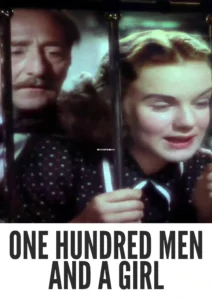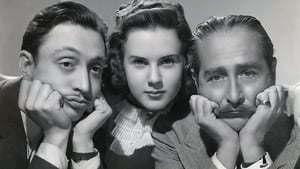Video Sources 0 Views

Synopsis
A Symphony of Dreams: One Hundred Men and a Girl (1937) in Vibrant Color

Step into the heartwarming world of One Hundred Men and a Girl, a delightful musical comedy from 1937, now beautifully colorized for a viewing experience like never before. This film, directed by Henry Koster, tells the inspiring story of a young girl who rallies a group of unemployed musicians. Perfect for classic film enthusiasts and those seeking an uplifting tale, this HD download brings a touch of old Hollywood magic to your screen. This film is also known as 100 Men and a Girl.
One Hundred Men and a Girl Storyline: A Young Girl’s Musical Mission
One Hundred Men and a Girl centers on Patricia Cardwell (Deanna Durbin), the determined daughter of an unemployed violinist. Seeing the struggles of her father and his fellow musicians, Patricia hatches a plan to create an orchestra and convince the renowned conductor Leopold Stokowski to lead them.Through her persistence and charm, Patricia manages to gather a hundred talented but jobless musicians. Her biggest challenge, however, is persuading the famous and temperamental Leopold Stokowski to take them seriously. After numerous attempts, she finally captures his attention, leading to a heartwarming and triumphant finale. One Hundred Men and a Girl is a feel-good movie that celebrates the power of music, perseverance, and youthful optimism.
Movie Cast
The film features a talented cast of actors who bring this musical story to life:
- Deanna Durbin as Patricia “Patsy” Cardwell
- Leopold Stokowski as Himself
- Adolphe Menjou as John Cardwell
- Eugene Pallette as Mr. Frawley
- Alice Brady as Mrs. Frost
Movie Genre
One Hundred Men and a Girl falls into the genre of musical comedy, with elements of heartwarming drama and family entertainment. Its uplifting story and musical performances make it a delightful and engaging film.
Historical Context: The Golden Age of Hollywood Musicals
Released in 1937, One Hundred Men and a Girl represents a highlight of the Golden Age of Hollywood musicals, showcasing the era’s optimism and emphasis on wholesome entertainment. The film was produced during a time when moviegoers sought escapism from the hardships of the Great Depression. One Hundred Men and a Girl not only provided a boost to Deanna Durbin’s career but also contributed to the popularity of classical music among mainstream audiences.
Colorization Details
This colorized version of One Hundred Men and a Girl has been meticulously restored using modern digital techniques, enhancing the visual appeal while preserving the film’s original charm. The colorization process involved carefully analyzing the grayscale tones of the original black and white footage and assigning appropriate colors to each scene. This painstaking process brings new life to the characters and settings, making the story even more engaging for modern audiences. While some may debate the merits of colorizing classic films, it introduces these films to a broader audience, ensuring their legacy for future generations.
Technical Details
- Director: Henry Koster
- Screenplay: Bruce Manning, James Mulhauser, Samuel Hoffenstein, Hans Kraly
- Story: Gregory Brook
- Cinematography: Joseph A. Valentine
- Edited by: Bernard W. Burton
- Production Company: Universal Pictures
- Distributed by: Universal Pictures
- Runtime: 84 minutes
Technical Specifications
- Download Format: MP4
- Resolution: HD (1080p)
- Compatibility: Compatible with most devices, including smartphones, tablets, computers, and smart TVs.
Reviews and Critical Reception
One Hundred Men and a Girl (1937) was a critical and commercial success, praised for its heartwarming story, musical performances, and Deanna Durbin’s captivating performance. The film’s blend of comedy and classical music resonated with audiences, making it one of the most beloved films of its time. As a testament to its enduring appeal, One Hundred Men and a Girl continues to be celebrated as a classic of the Golden Age of Hollywood.
FAQs
- Q: What is One Hundred Men and a Girl about?
- A: One Hundred Men and a Girl is about a young girl who helps a group of unemployed musicians form an orchestra and convinces Leopold Stokowski to conduct them.
- Q: Is One Hundred Men and a Girl (1937) a well-known film?
- A: One Hundred Men and a Girl is a celebrated classic from the Golden Age of Hollywood, known for its heartwarming story and musical performances.
- Q: Is this version of One Hundred Men and a Girl colorized?
- A: Yes, this version has been professionally colorized to enhance the viewing experience.
- Q: What makes One Hundred Men and a Girl interesting for classic film fans?
- A: One Hundred Men and a Girl offers a glimpse into the optimism and musicality of the Golden Age of Hollywood, showcasing Deanna Durbin’s talent and the appeal of classical music.
- Q: What is the download format?
- A: The download format is MP4, which is compatible with most devices.
- Q: What resolution is the download?
- A: The resolution is HD (1080p), providing a high-quality viewing experience.
Download Now in HD!
Watch One Hundred Men and a Girl Today!











